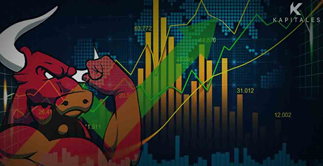
Market Alert: Trump-Xi APEC Summit a Critical Test for Global Trade Stability

In general, when we hear the word investor, the first image one generally creates is that an investor is a person who is a high-flying banker dressed in a suit and carries a suitcase. The perception here is partly correct. But the fact here is that we all are investors.
An investor is someone, a person, or an entity who commits capital in anticipation of getting a financial return. Not only in stocks, but investors also invest in different financial instruments to earn a rate of return and achieve their financial objectives. These financial instruments include derivatives, bonds, mutual funds, ETFs, real estate, etc.
Do Read: Investor or Trader- Who are you?
Investing in the stock market simply means purchasing the stock of a particular company. A stock is a security that represents an ownership share in the Company. Investors purchase a stock because they feel that the value of the stock would go up over time and they can make a profit.
A stock market is defined as a venue where buyers and sellers come together to buy and sell equity shares of a publicly listed company. Other than this, many new companies issue shares of the publicly held companies. These activities are conducted via institutionalized formal exchange or through the OTC market places. OTC stands for over-the-counter marketplaces.
The stock market brings together buyer and seller of shares to buy and sell and thus ensures that a fair pricing practices and transparency exists in transactions.

Earlier, most transactions were paper-based. However, because of digitization, it is possible to transact electronically.
When it comes to investing in the stock market, one popular name amongst investors is Warrant Buffet. Warren Buffet is an American businessman and philanthropist. He is amongst the most successful investors of all time.
Warren Buffet follows the Benjamin Graham school of value investing. He looks for stocks whose prices are low based on intrinsic value. Some of the factors he considers while selecting stocks include the company’s performance, debt, and profit margins. He also looks at commodity reliance, whether stocks are undervalued or overvalued.
Warren Buffet is a self-made man. He became rich over a long time through investing. He started investing at the early age of 11 years. As an adult, he started investing in companies he felt were undervalued and were making profits. He used to reinvest the profits from his investment. Gradually his wealth grew. Eventually, he bought Berkshire Hathaway, where he could continue with value investing.
Warren Buffet is now amongst the top 10 richest people in the world.
The concept of how the stock market works is quite simple. In the stock market, there are different vendors, comprising individuals and institutional investors engaged in buying and selling various products listed on the stock exchange. These institutional investors include hedge funds, pension plans, investment banks, etc. Stocks are traded either through a stock exchange or through OTC markets. There are different listing criteria for companies that want to use their services and raise capital in each of these markets.
In the stock market, the stock price keeps on changing as buyers and sellers reach the market to transact for any company’s stock. The price of the stock is influenced by the demand and supply of the company’s stock, the development made by the company, earnings and growth prospects, economic changes, elections, budget, policies within the country, and many more.

Stock prices on the exchange are determined by the demand and supply of the stocks. The maximum price that someone is willing to pay is the minimum price at which someone is willing to sell that particular stock. This we call ask price and bid price. The bid price is the price at which a dealer or a market participant is willing to buy a stock. Ask price is the price at which the seller is willing to sell the stock.
In case the demand for a particular stock is high, investors tend to buy more stocks than sellers willing to get rid of their holdings. As a result, the price of the stock moves up. On the other hand, if there are more sellers in the market selling their holdings, then the price of the stock would fall.
In the process of buying and selling the shares, it is important to understand that market makers play a crucial role in ensuring that buyers and sellers always exist.
Market makers buy and hold shares, and constantly list buy and sell quotations for shares. The highest price offered by the buyer is the bid price, and the lowest selling price offered is the ask price, and the difference between them is the spread.
Most people believe that to become successful in the stock market is to have a high-performing set of stocks. However, it is not only that but much above that. While equities offer the excitement of growing money, there are some basic rules to investing in the share market. These are:

Undoubtedly, stock market investment has the potential to compound investors’ wealth in the long run. However, many avoid it because of certain myths related to the stock market. This section will look at a few myths that can prevent investors from venturing into markets and result in a lost opportunity.

An investment is an asset or item acquired with the goal of generating income or appreciation. An investment involves putting capital to increase its value over time. A good purchased as an investment is generally not for consumption but used for creating wealth. It could be a bond, stock, real estate property, or business.
Investments generally fall under two categories- growth-oriented investment and fixed-income investment.
The growth-oriented investment aims at increasing the value of capital over time, and fixed-income investment seeks to provide a steady stream of income that can be paid to the investor or reinvested while aiming to maintain the original value of the investment.
Some of the investments under these two investment styles include:

Whether a person is an experienced player in the stock market or a new investor, at some point of time, have either heard or may hear the below terms.
Active portfolio managers seek to generate alpha in diversified portfolio to lessen unsystematic risk.
Stock, also known as equity, refers to the security that represents the ownership of a fraction of a corporation. A share refers to the stock certificate of a particular company. Companies issue stock to raise funds to operate their businesses. Stocks are bought or sold principally on the stock exchange. However, there can be private sales.
There are basically two types of stocks:
Common stocks refer to the security that represents ownership in a corporation. In case the company liquidates, common shareholders receive whatever asset is left after paying creditors, bondholders, and preferred stockholders. There are different stocks that trade on the stock market like a value stocks, growth stocks, penny stocks, etc.
Based on the risk appetite, investors diversify their portfolios.
Preference shares or preference stocks are shares of the company’s stock with dividends that are provided to the shareholders before common stocks. If the company enters the bankruptcy phase, preference shareholders are paid first from the company’s assets over common shareholders.
There are four types of risk-averse investors- cumulative, non-cumulative, participating, and convertible.
A primary market is a place where new stocks or bonds are sold to the public for the first time. This market is also called the new issues market. Most commonly, the new issues take the form of an IPO. Primary markets are facilitated by underwriting groups comprising investment banks that set the initial price range for a given security and manage its sale to investors. Once the initial sales are completed, the subsequent trading is conducted on the secondary market.
In the secondary market, a broker purchases securities on behalf of investors. Small investors get the opportunity to trade as they are excluded from the IPO. Investors trade the previously issued shares and the price of each stock is decided based on the demand and supply of the particular asset class.
In the OTC (over the counter) market, securities are traded between the counterparties, and there is no involvement of exchange in this process. The trading through OTC is facilitated either by a broker or a dealer specialising in OTC markets.
Generally, stocks that trade on the OTC market are stocks of small companies that cannot meet the exchange’s listing requirements.
A bull market refers to a market that is on the rise, and the economy is sound. In bull, the investors are optimistic that the stock or the industry is poised to move up in the coming period. Investors adopting the bull approach believe that the market will move up, and they can make more profits by selling them at a later stage.
Some of the characteristics of bull market include:


Some characteristics of bear market include:
A bear market is just the opposite of a bull market. In a bear market, investors are pessimistic with respect to any stock or the broader market. They believe that the prices will go down in the coming period. In such an environment, bearish investors tend to take short positions and make a profit.
Bearish market sentiment can be applied to all market types like commodity, stock, and bond markets. Technically, many experts say that a bear market happens when the underlying asset’s price drops 20% or even more than that from its recent highs.
Market correction refers to the moderate decline in the value of the market index or the price of the underlying asset in the range of 10% to 20% from the recent high.
Market correction happens because investors are more willing to sell their holdings instead of buying. The market moves for multiple reasons. These include the weakening of the economy, investors’ perceptions like fear of losses, and external events.

Generally, correction is for the short-term and could last for a few weeks or months. Once the economic shock or big political development or the reason influencing the market runs its course, we can see signs of recovery. In 2020, we saw a market correction for three months. Post that market bounced back.

Many times, people consider market correction and bear market the same. However, there is a slight difference. While market correction is for a smaller duration (lasting for a couple of weeks), the bear market represents a decline for a longer period. It can last more than 1 year. A market correction is the result of moderate concern about the market, while a bear market is more impactful.
During the market correction, experts believe that a diversified and disciplined approach helps to do well. It is also important to understand the reasons causing market correction. In case the existing changes are impacting the broader market, it could be a sign of extended market correction or a bear market.
Also Read: Process of Portfolio Management
A stock market crash refers to the drastic, often unforeseen drop in the prices of stocks listed on the stock exchange. There could be several reasons influencing the stock prices. Some of them include economic conditions, catastrophic events, and many more.
Some historical market crashes happened in 1929, 1987, 1999-2000, 2008, and 2020.

One cannot tell the specific threshold for a stock market crash. However, they are generally regarded as sudden double-digit percentage drops in the stock index within a few days. Market crashes impacts the economy significantly.

Stock market volatility refers to the price swing of the underlying asset from the mean price. It refers to the statistical measure of the dispersion of returns.
Volatility also refers to the amount of risk related to the size of changes in the security value. If the stock or any underlying asset is highly volatile, it means that its value can be spread out over a larger range of values. Precisely, we can say that if a stock is highly volatile, then the price can change dramatically over a short time span. On the other hand, if we say that the stock is less volatile, we mean that the value of the stock does not fluctuate dramatically and tends to be steadier.
Once we are familiar with the term volatility, we are often curious to know how to calculate volatility. The calculation of volatility is simple and is done using variance and standard deviation.
Step 1: In the first step, get the closing price of any stock for a certain period (let’s say 6 months).
Step 2: Add all the values and divide them by the number of values to get the mean price.
Step 3: In the third step, subtract all the closing price values from the mean value to get a deviation.
Step 4: Square the deviation value. It will eliminate any negative value.
Step 5: Add the squared deviation value and divide it by the number of entries. We get the variance.
Step 6: Square root the variance derived to get the standard deviation. The value obtained will help to understand the dispersion of the stock from the mean position.
Besides the standard deviation, one can calculate volatility using beta (β). A beta approximates the overall volatility compared to the benchmark index. A stock with β>1 means that the stock would deliver more return than the benchmark index and vice versa. For example: A stock has β= 1.2, it means that the stock has historically moved 120% for every 100% move in the benchmark index.
On the other hand, if the stock has β= 0.8, then we say that the stock has moved 80% for every 100% move in the benchmark or the underlying index.

Market volatility can also be checked using the volatility index or VIX. Other models like Black-Scholes or binomial tree models are used for pricing option contracts.
Volatility could be because of some of the below reasons:
Interesting Read: How to deal with market volatility?
IPO or Initial Public Offering refers to the process of offering shares of a private company to the public in a new stock issuance. Through IPO, the Companies can raise capital from public investors.
The Companies are required to meet the criteria of the exchange to hold an IPO.
Before an IPO, the company is considered private. As a pre-IPO company, the business has comparatively less shareholders like the founder, family members, and friends. The shareholders could also be venture capitalists or angel investors.

IPO provides the Company the access to raise a lot of money and, at the same time, provides a greater ability to grow and expand.
Trading on the stock market is done during the trading hours of the particular stock exchange.
In most countries worldwide, it is possible to have more than one Demat account. People generally open multiple accounts because of possible below reasons:
It is not necessary to work with a broker to buy stocks. However, investors need a brokerage, an online storefront where investors can purchase stocks, bonds, ETFs, and other investment products.
The Demat account helps investors hold and trade shares in an electronic format. A Demat account is also known as dematerialized account. It allows investors to keep track of all investments an investor makes in shares, ETFs, bonds, and mutual funds, all in a single place.
With a demat account, investors can:
Generally, there are 11 sectors on stock exchanges globally. These are:
Nextgen Global Services Pty Ltd trading as Kapitales Research (ABN 89 652 632 561) is a Corporate Authorised Representative (CAR No. 1293674) of Enva Australia Pty Ltd (AFSL 424494). The information contained in this website is general information only. Any advice is general advice only. No consideration has been given or will be given to the individual investment objectives, financial situation or needs of any particular person. The decision to invest or trade and the method selected is a personal decision and involves an inherent level of risk, and you must undertake your own investigations and obtain your own advice regarding the suitability of this product for your circumstances. Please be aware that all trading activity is subject to both profit & loss and may not be suitable for you. The past performance of this product is not and should not be taken as an indication of future performance.